Is It Possible to Predict the Timing of Mid−Season Drainage by Assessing Rice Canopy Light Interception?
Abstract
1. Introduction
2. Materials and Methods
2.1. Site Description
2.2. Rice Cultivars and Experimental Design
2.2.1. Field Experiment I
2.2.2. Field Experiment II
2.3. On−Farm Trial
2.4. Sampling and Measurement
- (1)
- The CLI value at the time when the tiller number reached 80% of the projected panicle number. In the current study, the panicle number at harvest was assumed to be the expected panicle number.where TTL_0.8 is the cumulative accumulated temperature at the time when the tiller number reached 80% of the projected panicle number; y0.8 is the tiller number per unit area of 80% of the projected panicle number; a0 is the tiller number per unit area at transplanting; af is the maximum tiller number per unit area; c and d are cultivar parameters; and T is the cumulative accumulated temperature after transplanting.
- (2)
- The CLI value at the time of maximum increases with tillering production. The derivative of the tillering−producing model between the stages of initiation and maximum tillering was calculated, and the CLI value at the maximum derivative was calculated.where TTLPmax is the cumulative accumulated temperature at the time at which the maximum increase in tillering occurs; a0 is the tiller number per unit area at transplanting; af is the maximum tiller number per unit area; c and d are cultivar parameters; and T is the cumulative accumulated temperature after transplanting.
- (3)
- The CLI value at the time of maximum increases with CLI development. The derivative of the CLI development model between the stages of initiation and maximum CLI was calculated, and the CLI value at the maximum derivative occurred was calculated.where TLIPmax is the cumulative accumulated temperature at the time at which the maximum increase in CLI occurs and CLImax is the maximum canopy light interception rate. CLIinit is the canopy light interception at transplanting; T is the cumulative accumulated temperature after transplanting; and r is the steepness of the curve, which is cultivated variety−dependent.
- (1)
- The CLI value PI;
- (2)
- The CLI value at 7 days prior to PI;
- (3)
- The CLI value at 10 days prior to PI.
2.5. Data Analysis
3. Results
3.1. Simulation of Dynamic Tillering DevelopmenSSt and Canopy Light Interception
3.2. The CLI Value for Initiation and Termination of MSD
The Timing of the CLI Value for MSD Termination
3.3. Analysis of Tillering Canopy Development Affects the Application of CLI
3.4. On−Farm Trial
4. Discussion
4.1. CLI Indicators for Predicting the Initiation and Termination of MSD
4.2. Factors Influencing the Application of the Model
5. Conclusions
Author Contributions
Funding
Data Availability Statement
Conflicts of Interest
References
- Liu, Y.; Wan, K.; Tao, Y.; Li, Z.; Zhang, G.; Li, S.; Chen, F. Carbon Dioxide Flux from Rice Paddy Soils in Central China: Effects of Intermittent Flooding and Draining Cycles. PLoS ONE 2013, 8, e56562. [Google Scholar] [CrossRef] [PubMed]
- Yoshida, S. Fundamentals of Crop Science; International Rice Research Institute: Los Baños, Philippines, 1981; p. 269. [Google Scholar]
- Bouman, B.A.M.; Humphreys, E.; Tuong, T.P.; Barker, R. Rice and Water. In Advances in Agronomy; Elsevier: Amsterdam, The Netherlands, 2007; Volume 92, pp. 187–237. ISBN 978-0-12-373686-4. [Google Scholar]
- Lampayan, R.M.; Rejesus, R.M.; Singleton, G.R.; Bouman, B.A.M. Adoption and Economics of Alternate Wetting and Drying Water Management for Irrigated Lowland Rice. Field Crops Res. 2015, 170, 95–108. [Google Scholar] [CrossRef]
- Stoop, W.A.; Uphoff, N.; Kassam, A. A Review of Agricultural Research Issues Raised by the System of Rice Intensification (SRI) from Madagascar: Opportunities for Improving Farming Systems for Resource-Poor Farmers. Agric. Syst. 2002, 71, 249–274. [Google Scholar] [CrossRef]
- Rahman, M.M. Nutrient-Use and Carbon-Sequestration Efficiencies in Soils from Different Organic Wastes in Rice and Tomato Cultivation. Commun. Soil Sci. Plant Anal. 2013, 44, 1457–1471. [Google Scholar] [CrossRef]
- Shiratori, Y.; Watanabe, H.; Furukawa, Y.; Tsuruta, H.; Inubushi, K. Effectiveness of a Subsurface Drainage System in Poorly Drained Paddy Fields on Reduction of Methane Emissions. Soil Sci. Plant Nutr. 2007, 53, 387–400. [Google Scholar] [CrossRef]
- Zou, J.; Huang, Y.; Zheng, X.; Wang, Y. Quantifying Direct N2O Emissions in Paddy Fields during Rice Growing Season in Mainland China: Dependence on Water Regime. Atmos. Environ. 2007, 41, 8030–8042. [Google Scholar] [CrossRef]
- Furukawa, Y.; Shiratori, Y.; Inubushi, K. Depression of Methane Production Potential in Paddy Soils by Subsurface Drainage Systems. Soil Sci. Plant Nutr. 2008, 54, 950–959. [Google Scholar] [CrossRef]
- Osaki, M.; Nursyamsi, D.; Begum, H.H.; Watanabe, T. Study on Aluminium Resistance in Relation to Organic-Acid Anion Exudation from Roots of PEPC Transgenic Rice Plants. In Plant Nutrition; Horst, W.J., Schenk, M.K., Bürkert, A., Claassen, N., Flessa, H., Frommer, W.B., Eds.; Springer Netherlands: Dordrecht, The Netherlands, 2001; pp. 514–515. ISBN 978-0-7923-7105-2. [Google Scholar]
- Qin, X.; Li, Y.; Wang, H.; Liu, C.; Li, J.; Wan, Y.; Gao, Q.; Fan, F.; Liao, Y. Long-Term Effect of Biochar Application on Yield-Scaled Greenhouse Gas Emissions in a Rice Paddy Cropping System: A Four-Year Case Study in South China. Sci. Total Environ. 2016, 569, 1390–1401. [Google Scholar] [CrossRef]
- Peng, S.; Garcia, F.V.; Laza, R.C.; Sanico, A.L.; Visperas, R.M.; Cassman, K.G. Increased N-Use Efficiency Using a Chlorophyll Meter on High-Yielding Irrigated Rice. Field Crops Res. 1996, 47, 243–252. [Google Scholar] [CrossRef]
- Monteith, J.L. Solar Radiation and Productivity in Tropical Ecosystems. J. Appl. Ecol. 1972, 9, 747. [Google Scholar] [CrossRef]
- Gifford, R.M.; Jenkins, C.L.D. Prospects of Applying Knowledge of Photosynthesis toward Improving Crop Production. Photosynthesis 1982, 2, 419–457. [Google Scholar] [CrossRef]
- Jayakumar, M.; Khrisnasamy, S.; Thavaprakash, N. Effect of Irrigation Regimes, Mid-Season Drainage and Time of Application of Nitrogen on Growth and Yield of Hybrid Rice. Acta Agron. Hung. 2005, 52, 45–51. [Google Scholar] [CrossRef]
- Maillard, A.; Diquelou, S.; Billard, V.; Laine, P.; Garnica, M.; Prudent, M.; Garcia-Mina, J.-M.; Yvin, J.-C.; Ourry, A. Leaf Mineral Nutrient Remobilization during Leaf Senescence and Modulation by Nutrient Deficiency. Front. Plant Sci. 2015, 6, 317. [Google Scholar] [CrossRef] [PubMed]
- Sakamoto, C.M.; Shaw, R.H. Light Distribution in Field Soybean Canopies. Agron. J. 1967, 59, 7–9. [Google Scholar] [CrossRef]
- San-oh, Y.; Oclarit, R.P.; Ookawa, T.; Motobayashi, T.; Hirasawa, T. Effects of Planting Pattern on the Interception of Solar Radiation by the Canopy and the Light Extinction Coefficient of the Canopy in Rice Plants Direct-Sown in a Submerged Paddy Field. Plant Prod. Sci. 2006, 9, 334–342. [Google Scholar] [CrossRef]
- De-long, J. The Model of Relations of Rice Tillering to Light and Temperature Conditions. J. Integr. Plant Biol. 1982, 23, 247–250. [Google Scholar]
- Zou, Y.; Tang, Q.; Hu, C.; Liu, S.; Xiao, X. Dynamic Simulation for Rice Growth and Yield. II. The Comparison and Application of Rice Tillering Statistical Models. Crop Res. 1991, 5, 18–22. [Google Scholar]
- Qi, C.; He, H.; Shi, Q.; Zeng, X. Studies on the Relationship between the Characteristics of Dry Matter Production and Yield Potential in Large-Panicle Type Rice. Acta Agron. Sin. 1986, 12, 121–128. [Google Scholar]
- Jiang, J.-H.; Liu, Q.-M.; Lu, C.; Zhang, H.; Liu, X.-L.; Dang, X.-J.; Niu, F.-A.; Manamik, C.B.; Zhao, K.-M.; Hong, D.-L. Genetic Basis Dissection of Heterosis in Japonica Rice (Oryza sativa L.): Genetic Basis Dissection of Heterosis in Japonica Rice (Oryza sativa L.). Acta Agron. Sin. 2013, 38, 2147–2161. [Google Scholar] [CrossRef]
- Armstrong, R.A.; Eperjesi, F.; Gilmartin, B. The Application of Analysis of Variance (ANOVA) to Different Experimental Designs in Optometry. Oph. Phys. Opt. 2002, 22, 248–256. [Google Scholar] [CrossRef]
- Mazaheri, V.; Khodadadi, H. Heart Arrhythmia Diagnosis Based on the Combination of Morphological, Frequency and Nonlinear Features of ECG Signals and Metaheuristic Feature Selection Algorithm. Expert Syst. Appl. 2020, 161, 113697. [Google Scholar] [CrossRef]
- Darzi-Naftchali, A.; Shahnazari, A. Influence of Subsurface Drainage on the Productivity of Poorly Drained Paddy Fields. Eur. J. Agron. 2014, 56, 1–8. [Google Scholar] [CrossRef]
- Turner, N.C.; O’Toole, J.C.; Cruz, R.T.; Namuco, O.S.; Ahmad, S. Responses of Seven Diverse Rice Cultivars to Water Deficits I: Stress Development, Canopy Temperature, Leaf Rolling and Growth. Field Crops Res. 1986, 13, 257–271. [Google Scholar] [CrossRef]
- Darzi-Naftchali, A.; Karandish, F.; Šimůnek, J. Numerical Modeling of Soil Water Dynamics in Subsurface Drained Paddies with Midseason Drainage or Alternate Wetting and Drying Management. Agric. Water Manag. 2018, 197, 67–78. [Google Scholar] [CrossRef]
- Lin, W.; Chen, H.; Zhang, Z.; Xu, Q.; Tu, N.; Fang, C.; Ren, W. Research and Prospect on Physio-Ecological Properties of Ratoon Rice Yield Formation and Its Key Cultivation Technology. Chin. J. Eco-Agric. 2015, 23, 392–401. [Google Scholar] [CrossRef]
- Chang, T.-G.; Zhao, H.; Wang, N.; Song, Q.-F.; Xiao, Y.; Qu, M.; Zhu, X.-G. A Three-Dimensional Canopy Photosynthesis Model in Rice with a Complete Description of the Canopy Architecture, Leaf Physiology, and Mechanical Properties. J. Exp. Bot. 2019, 70, 2479–2490. [Google Scholar] [CrossRef] [PubMed]
- Wu, D.; Guo, Z.; Ye, J.; Feng, H.; Liu, J.; Chen, G.; Zheng, J.; Yan, D.; Yang, X.; Xiong, X.; et al. Combining High-Throughput Micro-CT-RGB Phenotyping and Genome-Wide Association Study to Dissect the Genetic Architecture of Tiller Growth in Rice. J. Exp. Bot. 2019, 70, 545–561. [Google Scholar] [CrossRef]
- Wilhelm, W.; Mcmaster, G. Importance of the Phyllochron in Studying Development and Growth in Grasses. Crop Sci. 1995, 35, 1–3. [Google Scholar] [CrossRef]
- Jaffuel, S.; Dauzat, J. Synchronism of Leaf and Tiller Emergence Relative to Position and to Main Stem Development Stage in a Rice Cultivar. Ann. Bot. 2005, 95, 401–412. [Google Scholar] [CrossRef]
- Alzueta, I.; Gabriela Abeledo, L.; Mignone, C.M.; Miralles, D.J. Differences between Wheat and Barley in Leaf and Tillering Coordination under Contrasting Nitrogen and Sulfur Conditions. Eur. J. Agron. 2012, 41, 92–102. [Google Scholar] [CrossRef]
- Davidson, D.J.; Chevalier, P.M. Preanthesis Tiller Mortality in Spring Wheat. Crop Sci. 1990, 30, 832–836. [Google Scholar] [CrossRef]
- Fraser, J.; Dougherty, C.T.; Langer, R.H.M. Dynamics of Tiller Populations of Standard Height and Semi-Dwarf Wheats. N. Z. J. Agric. Res. 1982, 25, 321–328. [Google Scholar] [CrossRef]
- Power, J.F.; Alessi, J. Tiller Development and Yield of Standard and Semidwarf Spring Wheat Varieties as Affected by Nitrogen Fertilizer. J. Agric. Sci. 1978, 90, 97–108. [Google Scholar] [CrossRef]
- Sparkes, D.L.; Holme, S.J.; Gaju, O. Does Light Quality Initiate Tiller Death in Wheat? Eur. J. Agron. 2006, 24, 212–217. [Google Scholar] [CrossRef]
- Xu, L.; Henke, M.; Zhu, J.; Kurth, W.; Buck-Sorlin, G. A Functional–Structural Model of Rice Linking Quantitative Genetic Information with Morphological Development and Physiological Processes. Ann. Bot. 2011, 107, 817–828. [Google Scholar] [CrossRef]
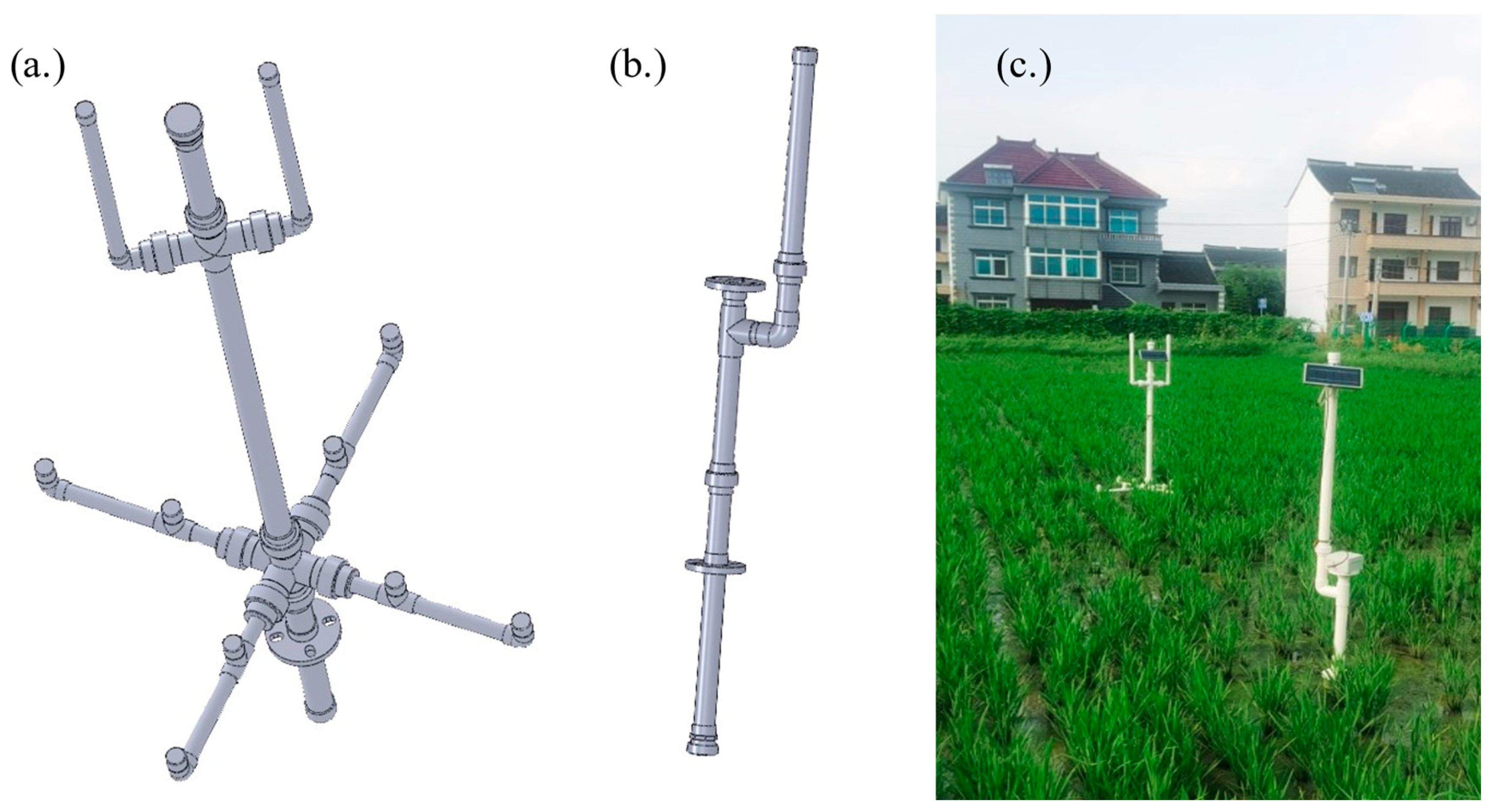

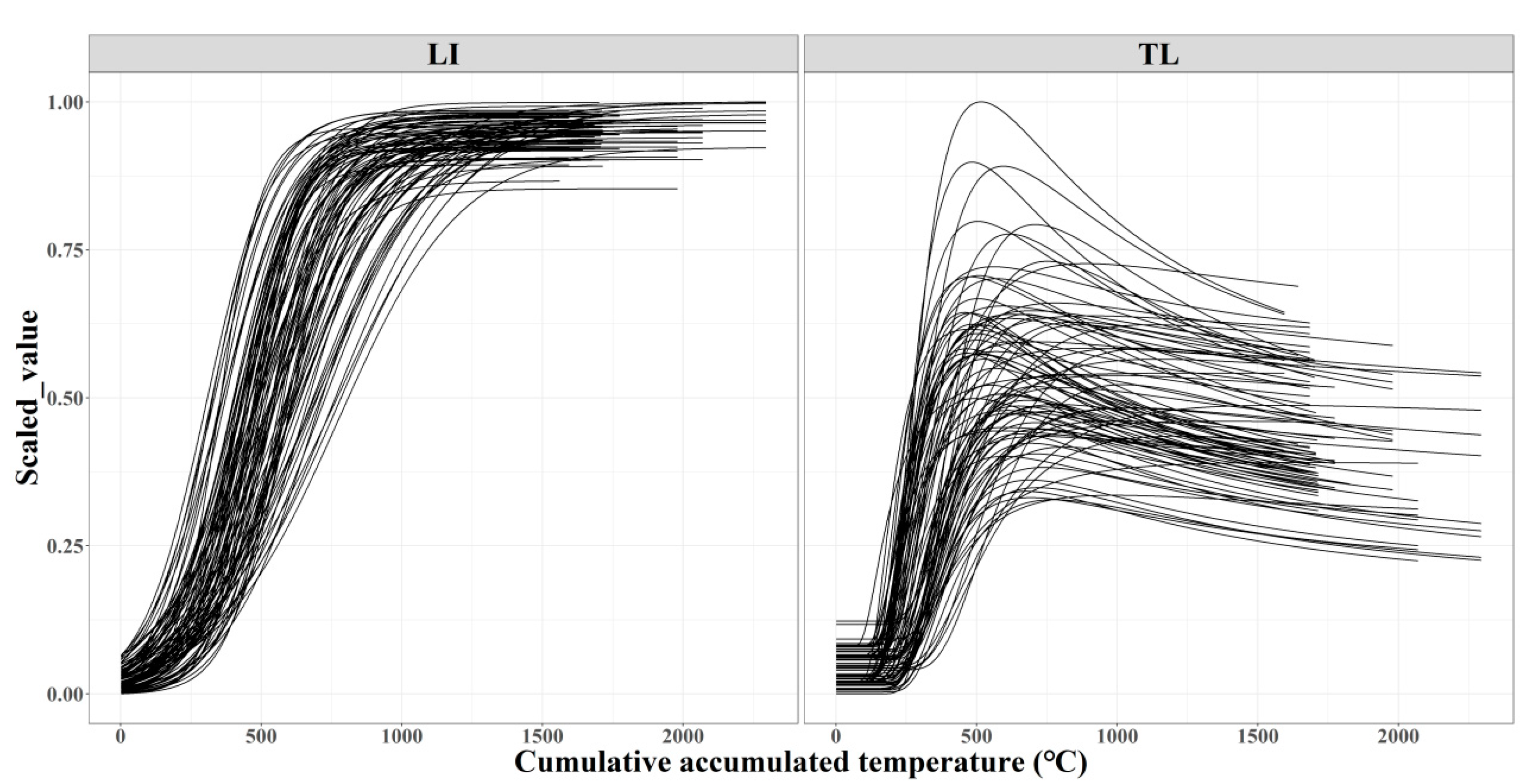
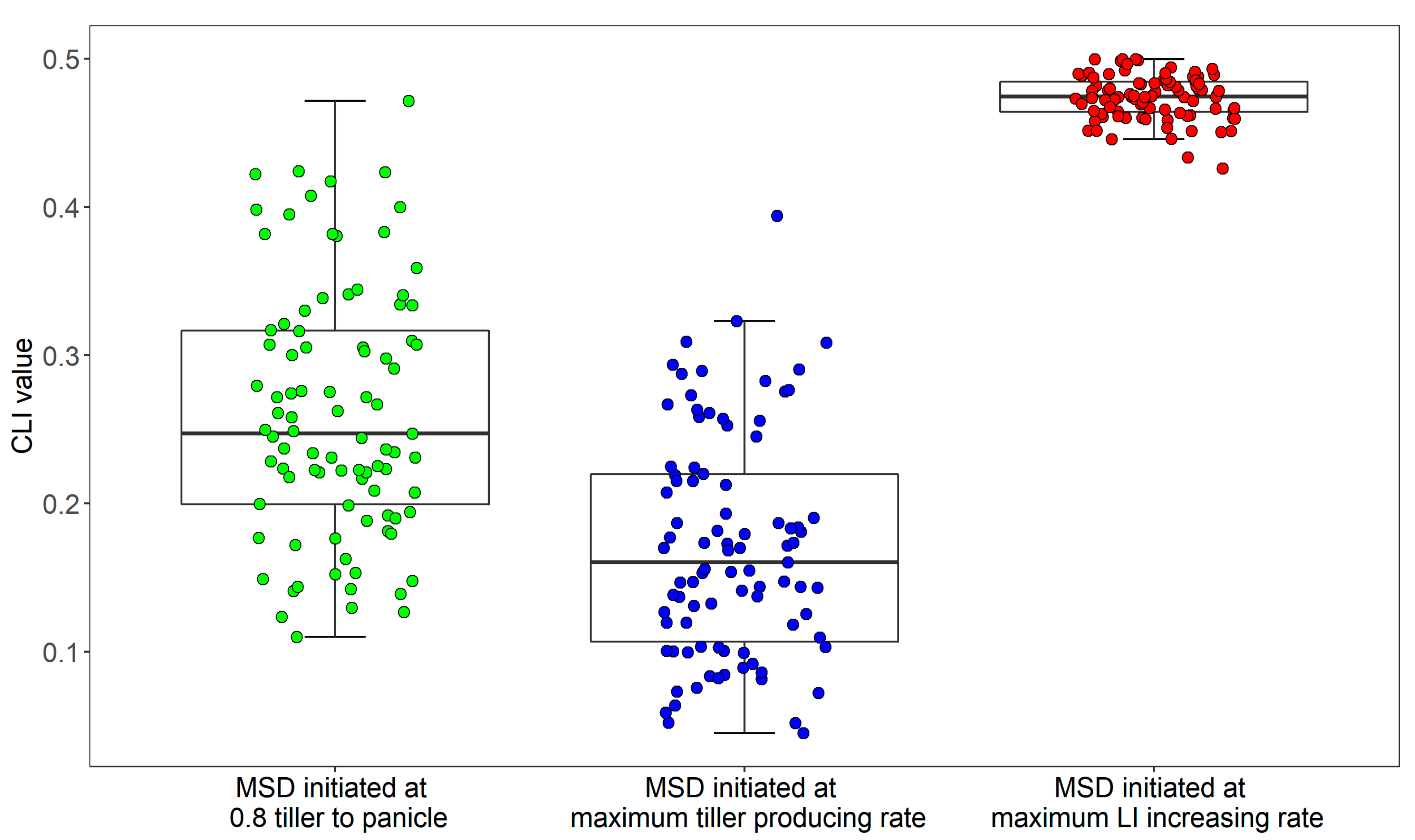
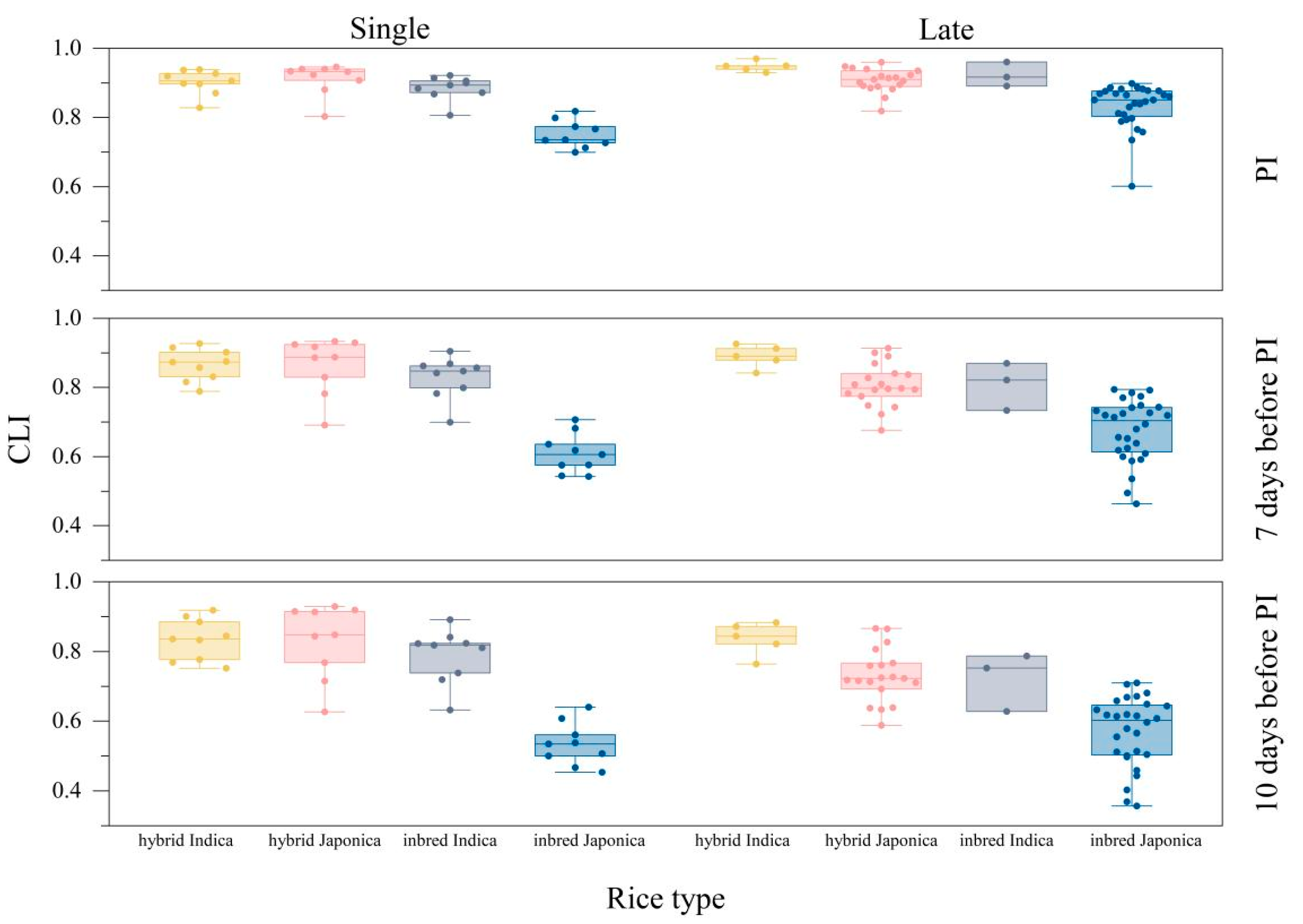
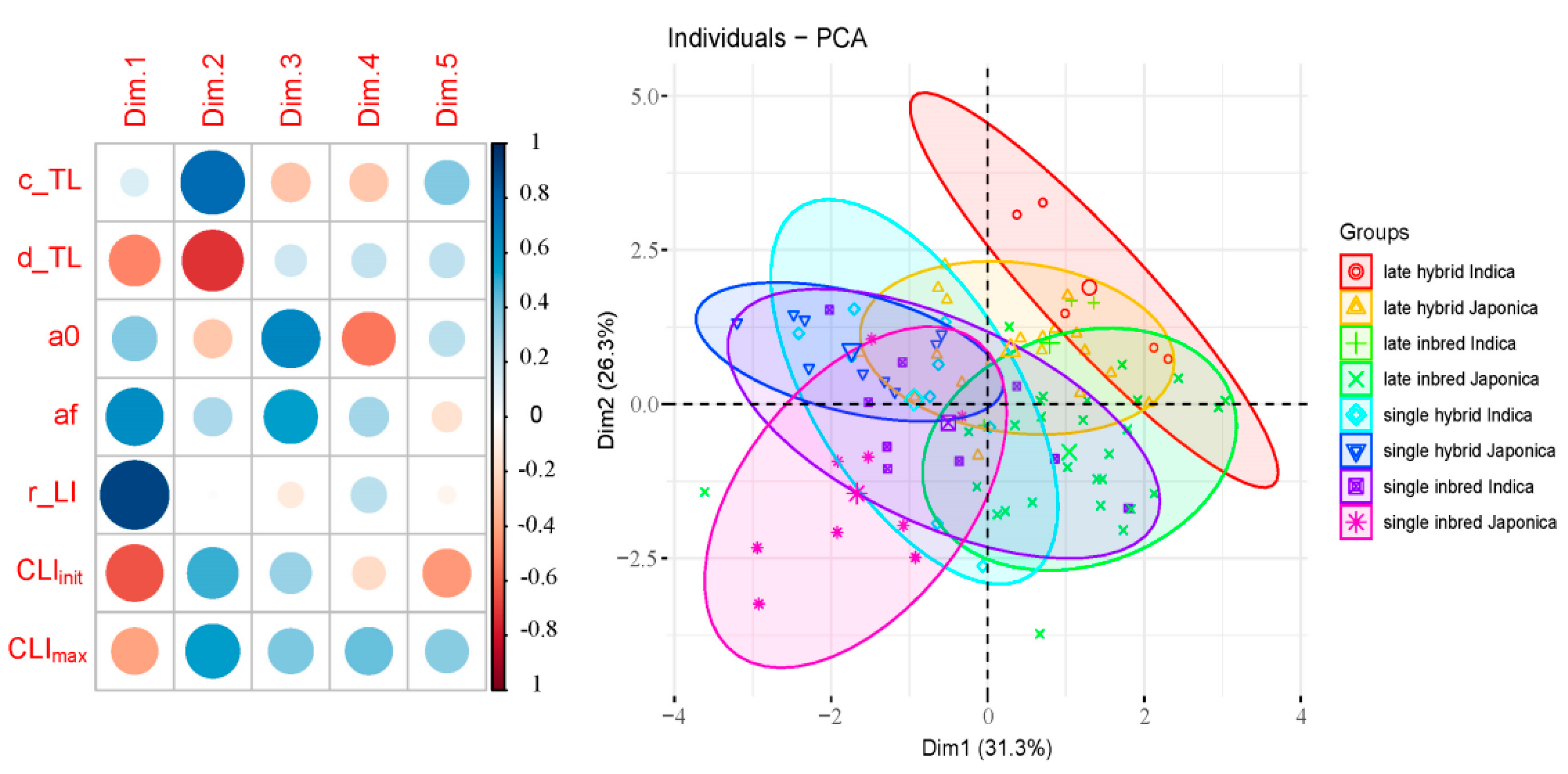
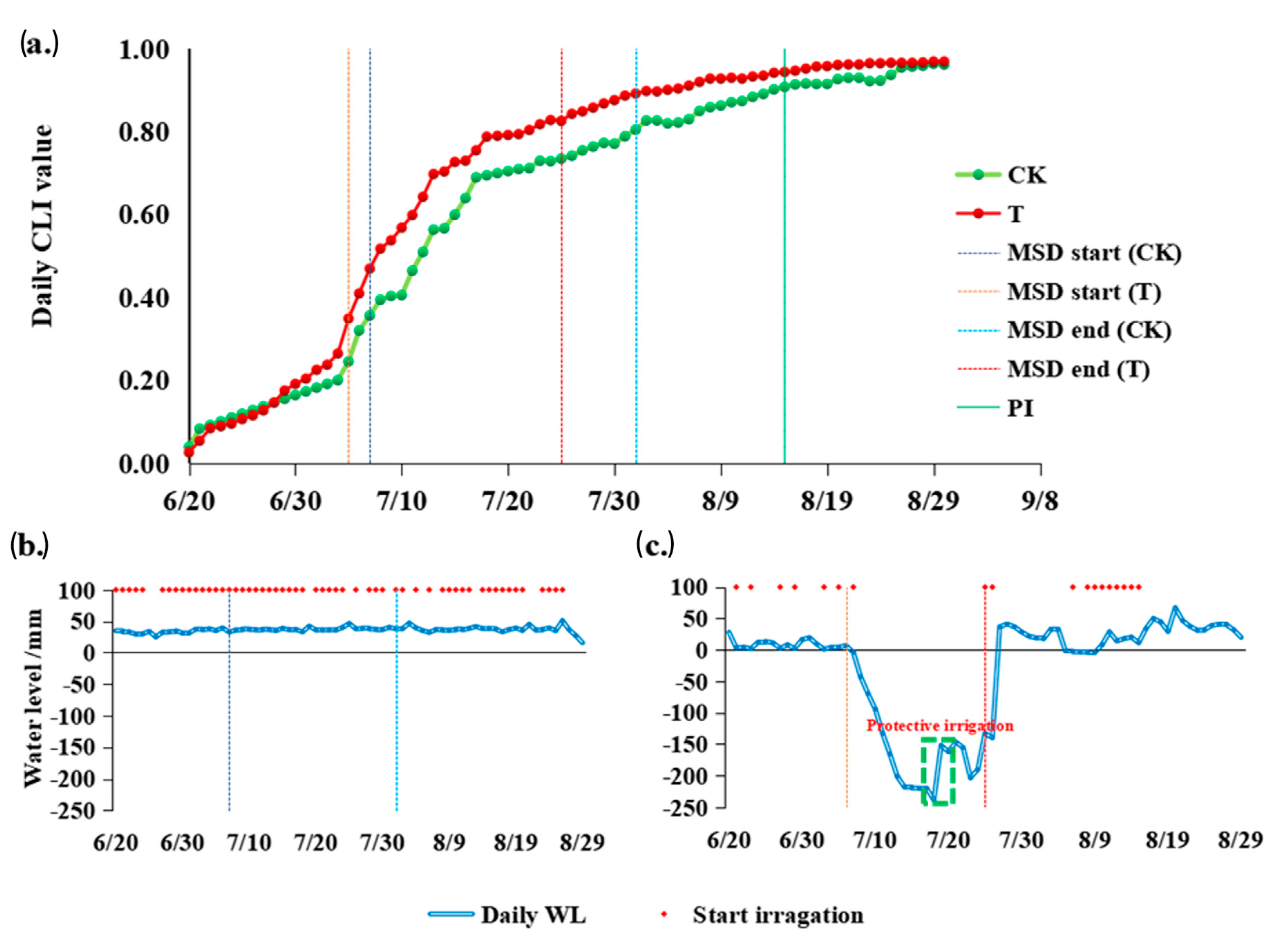
| Experiment | Year | Growth Season | Cultivars | Planting Dense (Hills per m2) | No. of Dataset | |
|---|---|---|---|---|---|---|
| Exp 1 | 2015 | Middle season | Huanghuazhan, Chunyou84, Tianyouhuazhan, Xiushui09 | 27 20, 16, 13 | 16 | |
| 2016 | Middle season | Huanghuazhan, Yongyou12, Tianyouhuazhan, Xiushui09 | 40, 27, 20, 16, 13 | 20 | ||
| Exp 2 | 2016 | Late season | Huanghuazhan, Jia58, Jia67, Nangeng46, Nangeng5055, Nangeng9108, Ninggeng1, Ninggeng2, Ninggeng3, Ninggeng4, Tianyouhuazhan, Xiushui09, Xiushui134, Yongyou1640, Yongyou2640, Yongyou538 | 24 | 16 | |
| 2017 | Late season | Cliangyouhuazhan, Huanghuazhan, Jia58, Changyou5, Chunyou84, Jiaheyou218, Nangeng46, Nangeng9108, Ninggeng1, Tianyouhuazhan, Xiushui134, Yongyou1540, Yongyou538 | 24 | 15 | ||
| 2018 | Late season | Chunyou927, Huxianggeng151, Huanghuazhan, Jia58, Jiahe218, Jiayou5, Nangeng46, Nangeng9108, Ninggeng4, Tianyouhuazhan, Wuyugeng24, Wuyugeng6567, Wuyungeng6571, Xiushui134, Yongyou12, Yongyou15, Yongyou1540, Yongyou538, Yongyou540, Yongyou8 | 24 | 20 | ||
| Season | Cultivated Variety Type | Mean | SE | Median | Quantile (25%) | Quantile (75%) |
|---|---|---|---|---|---|---|
| MSD start at 0.80 of tiller to panicle | ||||||
| Late | hybrid Indica | 0.31 | 0.03 | 0.27 | 0.27 | 0.34 |
| hybrid Japonica | 0.23 | 0.02 | 0.22 | 0.18 | 0.29 | |
| Inbred Indica | 0.28 | 0.03 | 0.31 | 0.26 | 0.31 | |
| inbred Japonica | 0.20 | 0.01 | 0.20 | 0.15 | 0.23 | |
| Single | hybrid Indica | 0.35 | 0.02 | 0.36 | 0.32 | 0.38 |
| hybrid Japonica | 0.25 | 0.01 | 0.23 | 0.23 | 0.25 | |
| inbred Indica | 0.38 | 0.02 | 0.40 | 0.31 | 0.42 | |
| inbred Japonica | 0.28 | 0.02 | 0.27 | 0.25 | 0.33 | |
| MSD start at max deriv of TL model | ||||||
| Late | hybrid Indica | 0.26 | 0.04 | 0.22 | 0.18 | 0.32 |
| hybrid Japonica | 0.17 | 0.02 | 0.15 | 0.10 | 0.25 | |
| inbred Indica | 0.23 | 0.04 | 0.26 | 0.20 | 0.27 | |
| inbred Japonica | 0.11 | 0.01 | 0.10 | 0.07 | 0.13 | |
| Single | hybrid Indica | 0.23 | 0.02 | 0.26 | 0.17 | 0.29 |
| hybrid Japonica | 0.18 | 0.01 | 0.17 | 0.17 | 0.19 | |
| inbred Indica | 0.23 | 0.02 | 0.22 | 0.22 | 0.28 | |
| inbred Japonica | 0.15 | 0.01 | 0.15 | 0.14 | 0.18 | |
| MSD start at max deriv of LI model | ||||||
| Late | hybrid Indica | 0.49 | 0.00 | 0.49 | 0.48 | 0.49 |
| hybrid Japonica | 0.48 | 0.00 | 0.48 | 0.47 | 0.49 | |
| inbred Indica | 0.49 | 0.00 | 0.49 | 0.49 | 0.49 | |
| inbred Japonica | 0.46 | 0.00 | 0.46 | 0.46 | 0.47 | |
| Single | hybrid Indica | 0.47 | 0.01 | 0.47 | 0.46 | 0.48 |
| hybrid Japonica | 0.48 | 0.00 | 0.48 | 0.48 | 0.49 | |
| inbred Indica | 0.47 | 0.00 | 0.47 | 0.47 | 0.48 | |
| inbred Japonica | 0.48 | 0.01 | 0.47 | 0.47 | 0.49 | |
| c_TL | d_TL | a0 | af | r_CLI | CLIinit | CLImax | |
|---|---|---|---|---|---|---|---|
| CLI MSD initiation | 0.12 ns | 0.30 ** | −0.07 ns | −0.03 ns | −0.47 *** | 0.56 *** | 0.15 ns |
| CLI 7 days before PI | 0.37 *** | −0.35 *** | −0.28 ** | 0.08 ns | 0.05 ns | 0.27 ** | 0.24 * |
| CLI 10 days before PI | 0.38 *** | −0.27 ** | −0.30 ** | 0.00 ns | −0.06 ns | 0.34 *** | 0.24 * |
| CLI Irrigation System | Traditional Irrigation | |||
|---|---|---|---|---|
| Items | Light sensor (¥) | 300 | Labor costs (¥) | 30–50 |
| Water level sensor (¥) | 150 | Water and power costs (¥) | 0–10 | |
| Water pumps (¥) | 500 | − | ||
| Equipment installation (¥) | 400 | − | ||
| Controllable areas (667 m2) | 20–50 | 1 | ||
| Available years (y) | 6 | 1 | ||
| Average (¥·y−1·667 m−2) | 4.5–16.8 | 30–60 | ||
Disclaimer/Publisher’s Note: The statements, opinions and data contained in all publications are solely those of the individual author(s) and contributor(s) and not of MDPI and/or the editor(s). MDPI and/or the editor(s) disclaim responsibility for any injury to people or property resulting from any ideas, methods, instructions or products referred to in the content. |
© 2023 by the authors. Licensee MDPI, Basel, Switzerland. This article is an open access article distributed under the terms and conditions of the Creative Commons Attribution (CC BY) license (https://creativecommons.org/licenses/by/4.0/).
Share and Cite
Ma, H.; Feng, X.; Yin, M.; Wang, M.; Chu, G.; Liu, Y.; Xu, C.; Zhang, X.; Li, Z.; Chen, P.; et al. Is It Possible to Predict the Timing of Mid−Season Drainage by Assessing Rice Canopy Light Interception? Agronomy 2023, 13, 402. https://doi.org/10.3390/agronomy13020402
Ma H, Feng X, Yin M, Wang M, Chu G, Liu Y, Xu C, Zhang X, Li Z, Chen P, et al. Is It Possible to Predict the Timing of Mid−Season Drainage by Assessing Rice Canopy Light Interception? Agronomy. 2023; 13(2):402. https://doi.org/10.3390/agronomy13020402
Chicago/Turabian StyleMa, Hengyu, Xiangqian Feng, Min Yin, Mengjia Wang, Guang Chu, Yuanhui Liu, Chunmei Xu, Xiufu Zhang, Ziqiu Li, Pince Chen, and et al. 2023. "Is It Possible to Predict the Timing of Mid−Season Drainage by Assessing Rice Canopy Light Interception?" Agronomy 13, no. 2: 402. https://doi.org/10.3390/agronomy13020402
APA StyleMa, H., Feng, X., Yin, M., Wang, M., Chu, G., Liu, Y., Xu, C., Zhang, X., Li, Z., Chen, P., Wang, D., & Chen, S. (2023). Is It Possible to Predict the Timing of Mid−Season Drainage by Assessing Rice Canopy Light Interception? Agronomy, 13(2), 402. https://doi.org/10.3390/agronomy13020402






